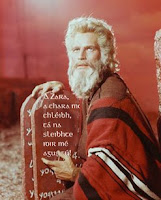 The late Charlton Heston, who died last night at his home in California after a long battle with Alzheimer’s, remarks in his autobiography In the Arena that his single greatest asset was his face.
The late Charlton Heston, who died last night at his home in California after a long battle with Alzheimer’s, remarks in his autobiography In the Arena that his single greatest asset was his face.
Some people’s faces fit, some don’t. One of the reasons put forward for the decline of the Western is that so few actors today would look well on a horse. It’s hard to imagine Tom Cruise, for instance, holding Fort Apache with Henry Fonda and John Wayne. Some people’s faces are of their time – Stephen Spielberg has remarked, for instance, that the biggest challenge in casting Saving Private Ryan was finding actors who faces looked like 1940s faces. Tom Sizemore’s role as the Sergeant tells how well they succeeded in that endeavour.
None of that applied to Heston. Heston’s biggest gift was that face, the face that represented Everyman. Or at least, Western Everyman – Heston’s portrayal of the Mexican policeman Miguel “Mike” Vargas takes the theory to the tipping point. But Touch of Evil excepted, who else but Charlton Heston could have represented mankind at every stage of his evolution, from Moses through to El Cid to Michelangelo to the Omega Man to the astronaut George Taylor, the last man standing on the Planet of the Apes? Charlton Heston was born John Carter in Evanston, IL, eighty-four years ago. He got his first big break in 1952 in The Greatest Show on Earth, the circus movie directed by Cecil B de Mille, where Heston played the circus manager. The movie is remembered primarily for Jimmy Stewart as the clown – he never takes off the makeup during the movie, an extra-ordinary thing to ask of an actor of Stewart’s talent and star-wattage. Four years later, De Mille hired Heston to play Moses in his Technicolor remake of the Ten Commandments – a movie that looks a little outré now, but that must have been just like hearing the voice of God then.
Charlton Heston was born John Carter in Evanston, IL, eighty-four years ago. He got his first big break in 1952 in The Greatest Show on Earth, the circus movie directed by Cecil B de Mille, where Heston played the circus manager. The movie is remembered primarily for Jimmy Stewart as the clown – he never takes off the makeup during the movie, an extra-ordinary thing to ask of an actor of Stewart’s talent and star-wattage. Four years later, De Mille hired Heston to play Moses in his Technicolor remake of the Ten Commandments – a movie that looks a little outré now, but that must have been just like hearing the voice of God then.
And then, in 1959, came Ben-Hur, a Tale of the Christ, as Lew Wallace’s original novel was titled. Ben-Hur had been made already, as a silent movie in 1925, but by 1959 Hollywood was on the crest of a Bible-movie wave, starting with The Robe and Quo Vadis in 1950s and ending when The Greatest Story Ever Told wasn’t in the 1960s. Ben-Hur was the pinnacle of those movies, epic in every sense of the world, and it is the movie for which Heston will be forever remembered.
It is a pity to reduce Heston to that one picture, however, great and all as it is. An Spailpín always considers The Big Country, directed by Ben Hur’s William Wyler a few years before Ben-Hur itself as a particular treat. Heston is part of a tremendously strong ensemble cast and plays Steve Leach, a ranch foreman who has the hots for the rancher’s daughter, the rancher’s daughter, however, having no interest in getting involved with the help. Watching it, it’s hard not to wonder how Heston would have fared had he been cast against type as Henry Fonda was in Once Upon a Time in the West.
For cineastes who wish to look beyond the Prince of Hur, An Spailpín Fánach posits the view that Heston’s greater legacy will be the three hugely influential science fiction movies he made in the 1960s and 70s – Planet of the Apes, Soylent Green and The Omega Man. The Omega Man was remade recently with Will Smith, re-titled I Am Legend, while Tim Burton’s 2001 remake of Planet of the Apes remains the nadir of an otherwise stellar career. Soylent Green has not been remade, of course, because that future is more than likely already here.
Heston in despair on the beach on the Planet of the Apes, looking at the sunken statue of liberty, represents us all. It is one of the iconic images in all cinema, and only Heston, with his Everyman face and gloriously gravely voice, could have carried it off. Ar dheis Dé go raibh a anam uasal.
Technorati Tags: culture, movies, Charlton Heston, Ben-Hur, Planet of the Apes
Sunday, April 06, 2008
So. Farewell Then, Charlton Heston
Posted by An Spailpín at 9:52 PM
Labels: Ben-Hur, Charlton Heston, culture, movies, obituary, Planet of the Apes


